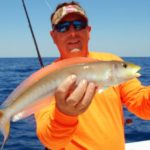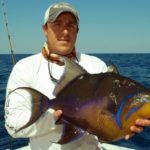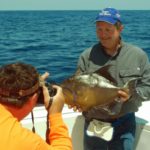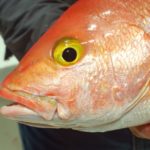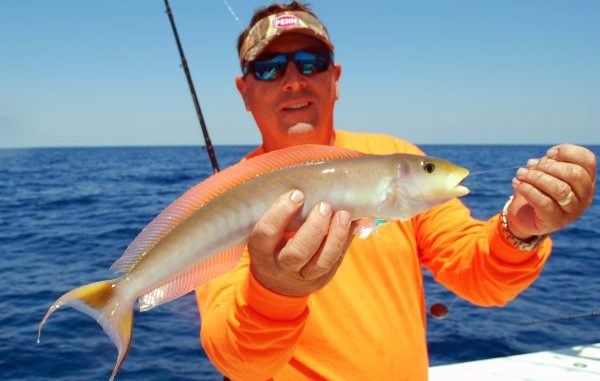
While most offshore anglers hit rigs and artificial reefs for a few red snapper and perhaps some AJs, this captain heads to natural hard bottoms and fills his box with a wide variety of species few would recognize.
Our boat was drifting on a cobalt-blue sea about 220 over a limestone-capped, coralline-encrusted “mountain.” We were out to catch what our skipper, Tommy Pellegrin, called “Cocodrie exotics” — a term he uses to describe the big variety of reef fish he catches from natural bottoms.
Although Pellegrin is a charter captain, (Custom Charters 985-851-3304) this trip was a “friends trip.” Joining him are Andre’ Thomas, Rob Dupont, Jay Walker and Stephen Griffin. The latter two are bankers with South Louisiana Bank. Walker is senior vice-president of lending in Houma, and Griffin is vice-president of the Acadiana Region for the bank in Abbeville.
“We’re here checking on our investment,” grinned Walker.
Pellegrin’s wife Laurie also works with Walker.
The remaining two were clearly fishing fanatics, perhaps not as bad as Pellegrin (he fished with two rods held in hand part of the day), but bad enough.
André Thomas moved 2,500 miles from the San Francisco Bay area to fish.
“I love to fish, and I wanted to live in Louisiana my whole life,” he said. “I told my girlfriend (and future wife) that I wanted to live in Louisiana — if she didn’t want to live here, then I wasn’t the man for her.”
He has a full-time job with the East Baton Rouge Housing Authority, but works as a deckhand for Pellegrin on his days off. Pellegrin called him his “official tagging expert,” noting that Thomas won an award last year for tagging the most red snapper in the state.
Dupont hails from Plaquemine but has a camp at Bayou Dularge. His family owns a large wholesale plant nursery, but he is a licensed charter captain and has been edging into the charter industry with his own business, Impulse Fishing Charters.
The youngest of the group, at 34, Dupont has boundless energy, is a skillful fisherman and fished no less ferociously than Thomas. He also pinch-hits as a deck hand for Pellegrin.
The purpose of the excursion was to demonstrate that there are other fish besides red and mangrove snappers to catch. And before the anglers dropped the first bait to the rocks of Ewing Bank — what Pellegrin refers to as “Wonderland” — they had some unexpected variety: When they stopped to cast-net for pogies, they jumped a school of bull redfish.
The hooligans were smashing the little silver fish to smithereens. After each man caught (and released because their possession is illegal in federal waters) one of the muscular fish, they continued on their way offshore.
On the initial drift at Ewing Bank, the first fish up was a punishing amberjack caught by Griffin, followed by a fish that puzzled Pellegrin — a mangrove snapper, the first of two to be caught that day.
“I’ve never caught one out here before,” Pellegrin said. “They have dogs and cuberas (snappers) out here, but not mangroves.”
He checked it closely to be sure it wasn’t a small cubera snapper.
These were followed closely by an almaco jack caught by Dupont and a scamp grouper hooked by Pellegrin, who nodded toward the latter with approval.
“That qualifies as an exotic,” he said.
Those fish were quickly followed by more amberjacks and an almaco jack.
“We gotta move,” muttered Pellegrin after he called for all lines to come up. “This is normally a jack spot, but last time we caught all our exotics here.”
The new spot wasn’t much better — at first. Jack after jack came up until Pellegrin sang out, “There’s your queen triggerfish, Jerald.”
Early in our discussion about exotics, I had groused about never having seen a live, on-the-hoof queen trigger. It was stunningly beautiful.
The triggerfish was followed by a scamp landed by Thomas, who had been quietly working a butterfly jig while the others fished with bait.
Then Pellegrin’s eye caught a flash of action, and he tossed a handful of pogies into the water. Big fish immediately started smashing the surface.
Pellegrin threw a big surface popper, which an outsized amberjack completely swallowed. All the devil broke loose.
Three big amberjacks, one big turbo-sized bonita and three blackfin tuna later, Pellegrin was elated. He needed fresh tuna for a sashimi feed later in the week.
After boxing the tuna, the men got down to the serious business of fishing for exotics on a new drift.
The move immediately paid off, and Pellegrin sounded like a ring announcer.
“There’s a red porgy,” he said. “Look here, a sand tile (tilefish), Wow, there’s a knobby (knobbed porgy). I see red — it’s a yellow-eye (silk snapper). There’s another yellow-eye — no, it’s a blackfin.”
When the drift took the boat to the drop-off that signaled the edge of the bank and the fish stopped biting, he cranked the motors and circled back to make another drift parallel to the previous one, but about 100 yards away.
The fish kept coming.
Pellegrin got excited and began fishing with a rod under each arm.
“Rob,” he counseled, “if you jerk, you pull the hook out of their mouths. It defeats the whole purpose of a circle hook.”
A moment later, in excitement, Pellegrin yanked the rod upward hard. Dupont looked at his friend and laughed loudly.
Chagrinned, Pellegrin sighed, “Doggone it; after I preach so much.”
The excitement was contagious. Sometimes every rod was bent to a fish. In the midst of the action, Walker brought up another big queen triggerfish.
To an average Louisiana offshore angler, these fish are indeed exotic. Red porgies, at first glance appear silver, but when the light hits them right, they show why in some places they are called pink snapper. They light-up with mother-of-pearl, pinkish highlights, punctuated by an iridescent blue bar under each eye. At one stage, so many were coming over the rail that the deck was littered with them.
Changing the pace was a sprinkling of knobbed porgy. Generally silver in color, with a comically sloping forehead, they offer just as good table fare as their red porgy cousins.
With every drift, it seemed that silk snappers, which Pellegrin invariably dubbed yellow-eyes, seemed to increase in number. Pellegrin’s nickname was appropriate. They were easy to separate from red snappers by their bright-yellow eyes and the yellow margins on their dorsal fins.
Many were decent-sized fish — 6 to 8 pounds.
Blackfin snappers greatly resemble red snappers, making one wonder how many of them have been released by unknowing red snapper fishermen who mistook them for red snappers during the closed red snapper season.
Only when one knows what to look for — the sooty black spot at the very base of each pectoral (side) fin — does the diagnostic feature jump out.
Sand tilefish are odd-looking creatures, with an elongated body and a lyre-shaped tail. These willing biters show a range of pastel colors, heavily highlighted with yellow. Their heads are most beautiful, with wiggly purple and gold lines and bright-yellow jaws.
On what turned out to be the last drift of the day, it was all red snappers — every fish. No one groaned. No one grumbled about regulations.
They had the boat’s huge ice-box full of fish. Their arms ached. So they quit — happy.
